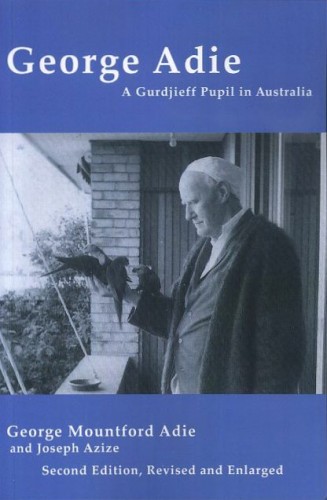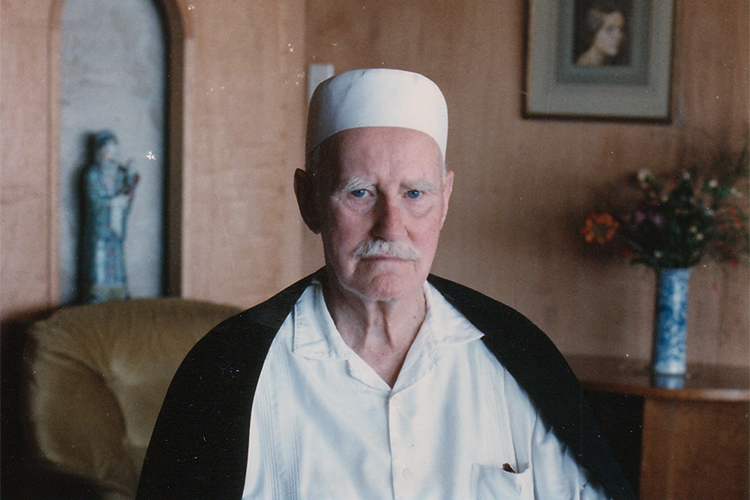 George Adie:
A Gurdjieff Pupil in Australia
George Adie:
A Gurdjieff Pupil in Australia
George Mountford Adie and Joseph Azize.
Second Edition, Revised and Enlarged. By the Way Books
(www.bythewaybooks.com), 2015. PP. 418. $35 Paper
Reviewed by Jeff Zaleski
The first extensive account of the spiritual teacher G.I. Gurdjieff by one of his students appeared in 1949 (the year Gurdjieff died), in P.D. Ouspensky’s classic In Search of the Miraculous. Memoirs by Gurdjieff’s students followed in a steady stream over the years, until all those who had worked with Gurdjieff as adults had passed away.
What may have been the first extensive account of working with one of those pupils of Gurdjieff surfaced in 1983, in Gurdjieff Group Work with Willem Nyland, by Irmis Popoff; Nyland was a Dutch-American chemist who first encountered Gurdjieff in 1924. In subsequent years, books about Gurdjieff’s direct pupils generated their own river of words, and quite recently the flow has increased with initial accounts by third-generation Gurdjieffians of men and women who studied under men and women who were taught by Gurdjieff.
The Gurdjieff Work is a living, oral teaching meant to be pursued in the company of others. Of what value are all these memoirs, all these books, virtual vehicles that lack the immediate presence of an embodied teacher? Of considerable value, perhaps, depending upon the book and, equally, upon the reader. George Adie: A Gurdjieff Pupil in Australia is a case in point.
As the subtitle reveals, George Adie is one of the many volumes by or about a direct student of Gurdjieff; Adie (1901–1989) began to study with Ouspensky in 1934 and moved on to Gurdjieff in the years 1948–1949. Sometime later Adie left his native England for reasons of health and settled with his wife, Helen, in Australia. It was there, in 1981, that Adie met Joseph Azize, the coauthor of this book; the two remained teacher-pupil until Adie’s death in 1989.
The extensive text of George Adie divides into two parts. The first part consists mostly of Azize’s narrative accounts of his experiences with, and understandings of, Adie and the Gurdjieff Work and its adherents. In a chapter “Adie as Teacher,” for example, Azize writes of one of his fellow students:
Max was another one of our “difficult” people. We could not see why Max was there. He seemed to channel his ingenuity into avoiding work of any type, whether internal or external. He never seemed to change. When he brought his observations, Max always said the same thing, striking a mock-pathetic posture of “Here I stand, miserable wretch, now at last I see myself as I am.” One of our senior people, Stan, once told me that he asked Adie why he allowed Max to stay. Adie had paused slightly and replied only with a question: “Would you like to die like that?”
Azize’s narration throughout is clear, insightful, and unsparing of himself. It is also generous, sharing some treasures. He devotes an entire chapter, for instance, to Adie’s correspondence with Mme. de Salzmann, generally recognized as Gurdjieff’s closest student:
Adie’s conditions in Australia were again her concern in a letter of 30 April 1967. She said that now the Adies knew a condition which she had long had: of feeling alone and responsible for every decision…. There is no complaint in the letter, but rather an acknowledgement that the condition has been necessary for her: it has made her enquire ever more deeply into herself, and this enquiry can never be satisfied by any answer but only by the experience of an ever more searching enquiry.
Then there is the courageous letter written by Adie to Ouspensky less than two years after Adie signed on as Ouspensky’s pupil. The letter begins, without salutation:
Speaking broadly, I feel that certain elements or flavours seem to be lacking in the School or Classes.
These “tastes” or qualities in which the School seems to be deficient, are of the nature of the elements of LOVE and NOBILITY….
The second part of George Adie is a rich stew brimming with, as Azize states in his introduction, “papers by Adie, pieces of prose poetry, diary entries, recollections of his table talk, and transcripts of meetings.” While organized and edited by Azize, this material sources directly to Adie and covers topics such as “Doing”; “A Lot Can Be Learned from Failure”; “Objective Hope” and “Sunday Tasks.” Throughout, Adie’s understanding manifests:
I sit, quiet, attentive, and I work to achieve an inner balance. Then, after a certain time, silently, the beginning of an opening process is discernible; and I start to experience the finely balanced rhythm of conscious life.
Suddenly—I AM. I am present.
With amazement, I recognize this, as if new and for the first time.
The passage above reveals something extraordinary to us. We recognize its truth, based on experience. We share a commonality of understanding, albeit one that varies in depth and immediacy from one person to another, from one moment to another. And yet our common understandings are manifested and expressed by each of us in individual ways characteristic of ourselves.
The passage above transmits George Adie’s expression of a certain understanding. By contrast, here is how another student of Gurdjieff, William Segal, expresses his understanding of a similar inner process:
I am very still. I follow my breath. I watch the movement of thoughts and associations. Feelings become quiet. Activity in the head diminishes.
I remain very still, refusing the mind’s inclination to reach for anything. Thoughts and feelings come and go like floating clouds. They are not me.
The experience is at one and the same time, both active and passive. Through sensation of the body, I perceive that I am. Yet, I do not know who or what I am. I am witness to my existence.1
The value of these many memoirs lies just in this essential balance of universality and particularity—a universality of understanding with a particularity of expression. Each book, each testament to a life spent working, can inspire and instruct by offering a shock of recognition, a new idea, a fresh perspective, a particular experience allowing me to move toward what all humans share—and where one book does not speak to me, another may. In spiritual work, strength lies in diversity as well as in commonality.
Azize and Adie often reference “presence”; like understanding, it is a quality with universal aspects but one that can manifest only in individual humans.
“For us, Adie represented presence,” writes Azize. “We sensed that he had a full presence, and presence, he would say, makes the strongest impression of all.”♦
1William Segal, Opening (Continuum, 1998)
